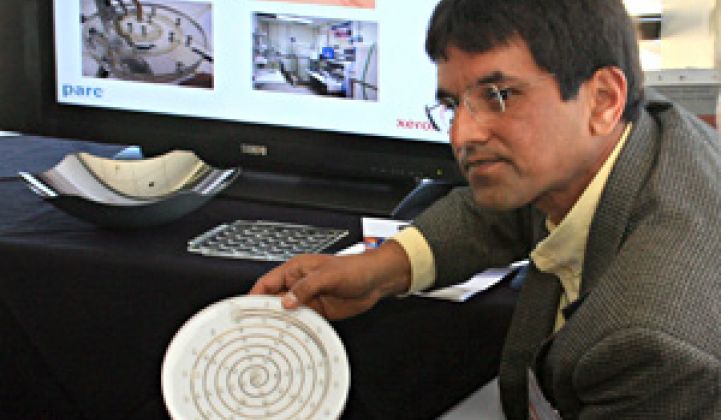Toner might not sound like something that could help clean water, but the Palo Alto Research Center hopes to use Xerox toner technology to do just that.
Using an electrostatic technology used to move toner powder along a surface – and that took a detour to help the Army move particles of biological weapons, such as anthrax spores, together in one place so they would be easier to detect – PARC has invented a water-treatment device that could cut costs for municipal water districts.
The technology uses centrifugal force in spiral-shaped channels to separate particles out of water. It uses no chemicals, filters or membranes, uses less energy than membrane-based particle-removal technologies and also is smaller than the systems used by municipal water districts today, said Scott Elrod, manager of the Clean Technology Program at PARC, a wholly owned subsidiary of Xerox.
The center hopes to demonstrate that the technology can filter particles out of 100 liters of water per minute, he said.
“That’s a gating item to know it has a strong commercial proposition,” he said. “We’re very close to doing that.”
Once that happens, PARC hopes to partner with a large integrated company, such as Siemens or General Electric, that already supplies water-purification equipment to municipalities and bring the technology to market, PARC President Mark Bernstein said.
The technology wouldn’t remove everything from the water and would have to be paired with purification technologies to remove chemicals, viruses and other particles smaller than 5 microns, said Elrod, who added the technology probably could be refined to remove particles of 1 micron and larger.
Another limitation is that the technology requires a constant flow rate, such as in a municipal water district or industrial application. The technology wouldn’t work for personal filtration systems such as hand pumps in developing countries, Elrod said.
Even for municipal water treatment, the spiraling technology faces challenges. The biggest is the need to control what’s called “biofouling,” or algae and other buildup clogging up the system, Elrod said.
“In order to be a breakthrough, it has to operate for long periods of time without cleaning or [maintenance], because one of the arguments we’re making is it’s simpler to operate,” he said. “There are questions around long-term usage and what happens and we don’t have data for long-term operation. That may be work we have to do with a partner.”
Still, Elrod said he believes PARC will be able to make it work reliably at a low cost.
Other challenges include a complex value chain and a market highly dependent on regulation, which is why PARC thinks partnering with an established player is the way to go. And Elrod said the center is “very close” to starting talks with potential partners.
Click here to read Reincarnation for Paper, Without Recycling



